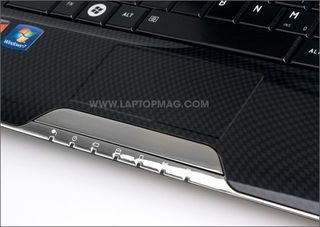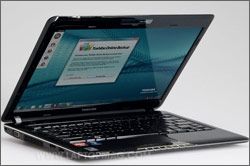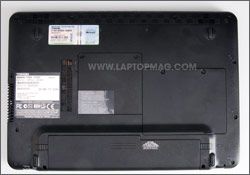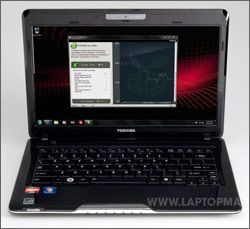Laptop Mag Verdict
The AMD version of this ultraportable offers better graphics performance than the Intel version for $100 less, albeit at the expense of battery life.
Pros
- +
Strong graphics performance
- +
Good wireless throughput
- +
Stylish design
Cons
- -
Narrow and stiff touchpad button
- -
Less battery life than Intel version
- -
Runs hot
Why you can trust Laptop Mag
Editor's Note: Portions of this review were taken from our earlier review of the Toshiba Satellite T135.
Thin, lightweight, and quite attractive, the Toshiba Satellite T135D-S1324 ($599) is a notebook that provides plenty of computing power without draining your bank account. This stylish 3.8-pound machine boasts an AMD processor and ATI graphics, and it lasts over five hours on a charge. Plus, this version of the T135 is $100 less expensive than its Intel counterpart, even though you'll sacrifice some battery life. We have some complaints about the touchpad buttons and heat, but overall this ultraportable offers some of the best performance we've seen at this price.
Design
The T135D features a glossy coating that commands your attention, and the Fusion Finish in Nova Black offers a dark, rich visual design with a subtle checkered pattern that's quite fetching. Available in black, red, and white, the T135D's subtle, houndstooth-esque pattern spreads across the lid, extending onto the keyboard deck and palm rest. Even the touchpad bears this pattern (although it has a textured finish). Because of this design, fingerprints remain more or less hidden. Coupled with metal accents on and around the touch button, the machine looks a bit more expensive (and rightfully so) than your average netbook.
At 3.8 pounds, the T135D is about as light as you'd expect an ultraportable system to be. That is to say, it's light and slim enough to hold in one hand. Even though the six-cell battery creates a slight bulge at the bottom, it was still easy to carry from room to room.
Heat
Although Toshiba was able to cram discrete graphics into the T135D, the thinness of the system contributes to poor heat dissipation. After playing a Hulu video at full screen for 15 minutes, the touchpad registered 101 degrees Fahrenheit, the space between the G and H keys reached 97 degrees, and the center of the underside was 105 degrees. The temperature by the exhaust vent rose to an unbearable 125 degrees. We consider anything over 95 degrees to be uncomfortable, and anything over 100 degrees to be unacceptable.
Keyboard and Touchpad

Click to enlarge
The T135D's keyboard feels a bit cramped. Toshiba could have easily fixed this issue by extending the layout from edge to edge. Instead, the notebook leaves nearly an inch on either end of the deck. The keys themselves are flat and arranged close together, with the right Shift key slightly shrunken and the four arrow keys wedged into the lower right corner--almost an afterthought.
The 3.2 x 1.6 multitouch touchpad has plenty of width, but not as much height, so it's easier to move horizontally then vertically. Unfortunately, the T135D doesn't borrow the two large touch buttons we loved so much in the mini NB205, the company's flagship netbook. Instead, this laptop has a single, narrow touch button. Although the metal design--similar to that on the Satellite U505--looks sleek, it can feel stiff if you accidentally press the center of the button, as opposed to the left and right edges.
Display and Audio

Click to enlarge
We enjoyed crisp and colorful images while watching episodes of Family Guy on the 13.3-inch (1366 x 768) display. Viewing angles are wide, so we were able to take in the show from all but the most extreme positions. That said, the glossy display did kick back a number of reflections, especially during dark scenes.
You may find yourself sitting close to the T135D, as the stereo speakers don't offer much punch. When listening to Curtis Mayfield's "Think (Instrumental)," we kept wishing for greater volume and extra bass.
Ports and Webcam

Click to enlarge
The T135D features a pretty standard array of connections, but we like that the USB port on the left side offers USB Sleep-and-Charge support, which lets you charge cell phones and other gadgets when the system is turned off. Also on the left are HDMI, VGA, and a Kensington lock slot. Built into the right side of the system are two USB 2.0 ports, headphone and mic jacks, an Ethernet jack, and a 5-in-1 memory card slot.
The 0.3-megapixel webcam's VGA video wasn't particularly sharp, nor are the colors vibrant, but the lighting was bright enough, and other Skype callers said our voice synced up with our lips as we spoke. The sound was accurate, too, if on the weak side. Since the smoothness is its most redeeming quality, we don't recommend taking still photos; you'll be stuck with grainy, splotchy images and pallid colors.
Performance
The 1.6-GHz AMD Turion Neo X2 L625 CPU, 4GB of RAM, and 320GB hard drive helped power the T135D to a PCMark Vantage score of 2,557, which is over 180 points below the 2,739 ultraportable category average. The Intel version of the T135, which used a 1.3-GHz Intel Pentium SU4100 CPU and 4GB of RAM, scored 2,701. Still, we had no trouble using the AMD-powered T135D for such everyday tasks as surfing the Web, writing documents, listening to music, and watching videos.
Performance results were a little more mixed on our transcoding tests. The T135D took 12 minutes and 23 seconds to transcode a 114MB MPEG-4 to AVI using HandBrake; the Intel-powered T135 finished in just 11:41. Still, both times are faster than the average ultraportable (13:34). However, when using Oxelon Media Converter to perform the same task, the T135D took 2:11. That showing is over twice as fast as the Intel T135 (4:36), and almost a minute longer than the Lenovo ThinkPad Edge 13.
The 5,400-rpm, 320GB HDD copied a 4.97GB folder of mixed media at a rate of 18.0 MBps, which is 3.0 MBps slower than the category average. The T135D booted to Windows 7 Home Premium in 55 seconds, 6 seconds faster than average.
Graphics Performance
While the Intel version of the T135 has integrated graphics, the AMD version uses the ATI Radeon HD 3200 chipset, which helped the system achieve a score of 1,048 in 3DMark06. That's almost 200 points higher than the ultraportable average, and 330 points higher than the Intel-based T135. When we output a 1080p Avatar trailer to a 32-inch Samsung HDTV via HDMI, video played back smooth as silk.
The ATI graphics enabled the T135D to deftly handle World of Warcraft--at least on the default settings. The game moved along at 30 frames per second at 1024 x 768 resolution, but dipped to just 6 fps at 1366 x 768, and effects set to Ultra. By comparison, the T135 managed just 23 fps at 1024 x 768, and 4 fps at its native resolution. It should be noted that the Nvidia Ion-powered HP Mini 311 from Verizon Wireless saw slightly better frame rates (35 fps and 14 fps, respectively) than both T135 models.
The AMD version of the T135 doesn't pack enough muscle to handle the graphics-intensive Far Cry 2; it managed to push polygons at a rate of 14 fps at 1024 x 768 resolution, and 4 fps at 1366 x 768. Even here, though, we saw the benefits of discrete graphics; the Intel T135 notched just 4 and 2 fps, respectively, on the same Far Cry 2 test.
Battery Life and Wi-Fi

Click to enlarge
The T135D's six-cell battery lasted 5 hours and 6 minutes on our LAPTOP Battery Test (continuous surfing over Wi-Fi). That's among the best runtimes we've ever seen from an AMD notebook, and you should be able to get through a good part of your workday unplugged. However, this showing is about 20 minutes shorter than the typical ultraportable, and the Intel-powered T135 (which has integrated graphics) lasted more than 2 hours longer on a charge.
We saw mixed results from the T135D's 802.11b/g/n Wi-Fi connection. At 15 feet from our access point, the system achieved a throughput of 29.1 Mbps, 8.6 Mbps faster than average. At 50 feet, speeds dropped to a more pedestrian 16.7 Mbps, just a shade under the average of 17.2 Mbps.
Green Testing
The T135D took a leisurely 2 hours and 48 minutes to recharge to 80 percent, and 3:52 to fully recharge, about 20 minutes longer than the category average of 3:35. During the charging process, the T135D drew a total of 7632.8 watts. Divide that by total battery life and you get a LAPTOP Battery Efficiency Rating of 24.9, which is higher than the category average (19.6). In this case, a lower figure is better. The T135D is not rated by EPEAT.
Software and Support

Click to enlarge
The T135 comes with a host of Toshiba utilities, such as PC Health Monitor. It also contains a 60-day trial of Microsoft Office 2007 and a 30-day trial of Norton Internet Security 2010. Toshiba also includes Bulletin Board and ReelTime, two applications that it introduced with the touchscreen-enabled U505. ReelTime is kind of like the poor man's time machine; it lets you scroll back to find previously opened documents and files. Bulletin Board allows you to place photos and notes on a blackboard in the middle of the screen. Also included is the Best Buy Software Installer, which is little more than a portal to purchase software online.
Verdict
At $599, the AMD-powered Toshiba Satellite T135D-S1324 gives you a strong bump in graphics performance. However, the $699 Intel ULV-powered version of this notebook lasts over two hours more on a charge, so it comes down to what you value most. In the 13-inch notebook class we prefer the ASUS UL30A, which costs only $50 more than the T135D when purchased via Amazon yet offers nearly 10 hours of battery life and bettery ergonomics. If, however, you're looking for robust graphics performance in a small, light, and inexpensive machine, the T135D-S1324 is a solid pick. While we're not enamored with its touchpad buttons and keyboard, this is a stylish and affordable ultraportable that will let you do a bit of gaming, too.
Toshiba Satellite T135D Specs
| Brand | Toshiba |
| CPU | 1.6-GHz AMD Turion Neo X2 L625 |
| Card Slots | 5-1 card reader |
| Company Website | http://www.toshibadirect.com |
| Display Size | 13.3 |
| Graphics Card | ATI Radeon HD 3200 |
| Hard Drive Size | 320GB |
| Hard Drive Speed | 5,400rpm |
| Hard Drive Type | SATA Hard Drive |
| Native Resolution | 1366x768 |
| Operating System | MS Windows 7 Home Premium (64-bit) |
| Ports (excluding USB) | Headphone, HDMI, Ethernet, eSATA, VGA, Microphone, Kensington Lock |
| RAM | 4GB |
| RAM Upgradable to | 8GB |
| Size | 12.7 x 8.8 x 1.4 inches |
| USB Ports | 2 |
| Video Memory | 2GB |
| Warranty/Support | One-year standard/24/7 toll-free phone |
| Weight | 3.8 pounds |
| Wi-Fi | 802.11b/g/n |
